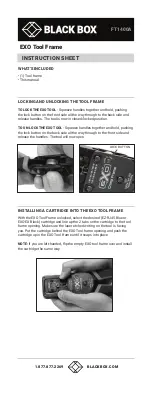
32
EngLIsh
Proper Hand Position (Fig. F)
WARNING:
To reduce the risk of serious personal injury,
ALWAYS
use proper hand position as shown.
WARNING:
To reduce the risk of serious personal
injury,
ALWAYS
hold securely in anticipation of a
sudden reaction.
Proper hand position requires one hand on the main handle,
with the other hand on the body for stabilisation.
Variable Speed Switch (Fig. A)
To turn the tool ON, squeeze the trigger switch
1
. To turn the
tool OFF release the trigger.
nOTE:
The LED worklight
9
will illuminate when the trigger
is depressed.
Your tool is equipped with a variable speed switch which
enables you to select the best speed for a particular application.
The farther you squeeze the trigger, the faster the tool will
operate. Use lower speeds for cutting tight curves or following
precise guideline. Higher speeds are better for gradual curves
and straight line cuts. For maximum tool life, use lower speeds
only for short periods of time.
On/Lock-Off Control Button (Fig. A)
An On/Lock-Off control button
3
serves as a lock-off button. To
select the ON position, release the trigger switch and depress
the control button on the right side of the tool. To select Locked/
Off, depress the control button on the left side of the tool. When
changing the position of the control button, be sure the trigger
is released.
Shearing (Fig. D, E)
WARNING: Cut Hazard. NEVER have any part of your
body near the blades
. Serious personal injury may occur.
WARNING: Cut Hazard. To reduce the risk of serious
personal injury, DO NOT
use the shear with any kind of
accessory or attachment.
WARNING: Cut Hazard.
Wear gloves when handling
sheet metal. The edges are sharp and can cause serious
personal injury.
For accurate work, always clamp or anchor the material to
be cut. Line up one edge of the tool’s middle blade with the
cutting line and advance blades into the material without forced
effort or unnecessary pressure. A little practice will enable you
to determine what forward pressure gives you the smoothest
cutting. It is important to keep the lower surfaces of the side
blades flat on the material being cut. When cutting curves, do
not tilt the tool; keep the side blades flat and level.The head of
the shear will swivel to afford better access to the material. For
best cutting efficiency, keep blades sharp.
MAINTENANCE
Your
D
e
WALT
power tool has been designed to operate
over a long period of time with a minimum of maintenance.
Continuous satisfactory operation depends upon proper tool
care and regular cleaning.
WARNING: To reduce the risk of serious personal
injury, turn tool off and disconnect battery pack
before making any adjustments or removing/
installing attachments or accessories.
An accidental
start-up can cause injury.
The charger and battery pack are not serviceable.
Lubrication
Certain parts of the shears head assembly require lubrication
with a high-quality grade bearing grease. Refer to
Remove and
Replace Parts
for details.
Cleaning
WARNING:
Blow dirt and dust out of the main housing
with dry air as often as dirt is seen collecting in and around
the air vents. Wear approved eye protection and approved
dust mask when performing this procedure.
WARNING:
Never use solvents or other harsh chemicals
for cleaning the non-metallic parts of the tool. These
chemicals may weaken the materials used in these parts.
Use a cloth dampened only with water and mild soap.
Never let any liquid get inside the tool; never immerse any
part of the tool into a liquid.
Optional Accessories
WARNING:
Since accessories, other than those offered
by
D
e
WALT
, have not been tested with this product, use
of such accessories with this tool could be hazardous.
To reduce the risk of injury, only
D
e
WALT
recommended
accessories should be used with this product.
Consult your dealer for further information on the
appropriate accessories.
Protecting the Environment
Separate collection. Products and batteries marked
with this symbol must not be disposed of with normal
household waste.
Products and batteries contain materials that can
be recovered or recycled reducing the demand for raw
materials. Please recycle electrical products and batteries
according to local provisions. Further information is available at
www.2helpU.com
.
Rechargeable Battery Pack
This long life battery pack must be recharged when it fails
to produce sufficient power on jobs which were easily done
before. At the end of its technical life, discard it with due care for
our environment:
• Run the battery pack down completely, then remove it from
the tool.
• Li-Ion cells are recyclable. Take them to your dealer or a
local recycling station. The collected battery packs will be
recycled or disposed of properly.
















































